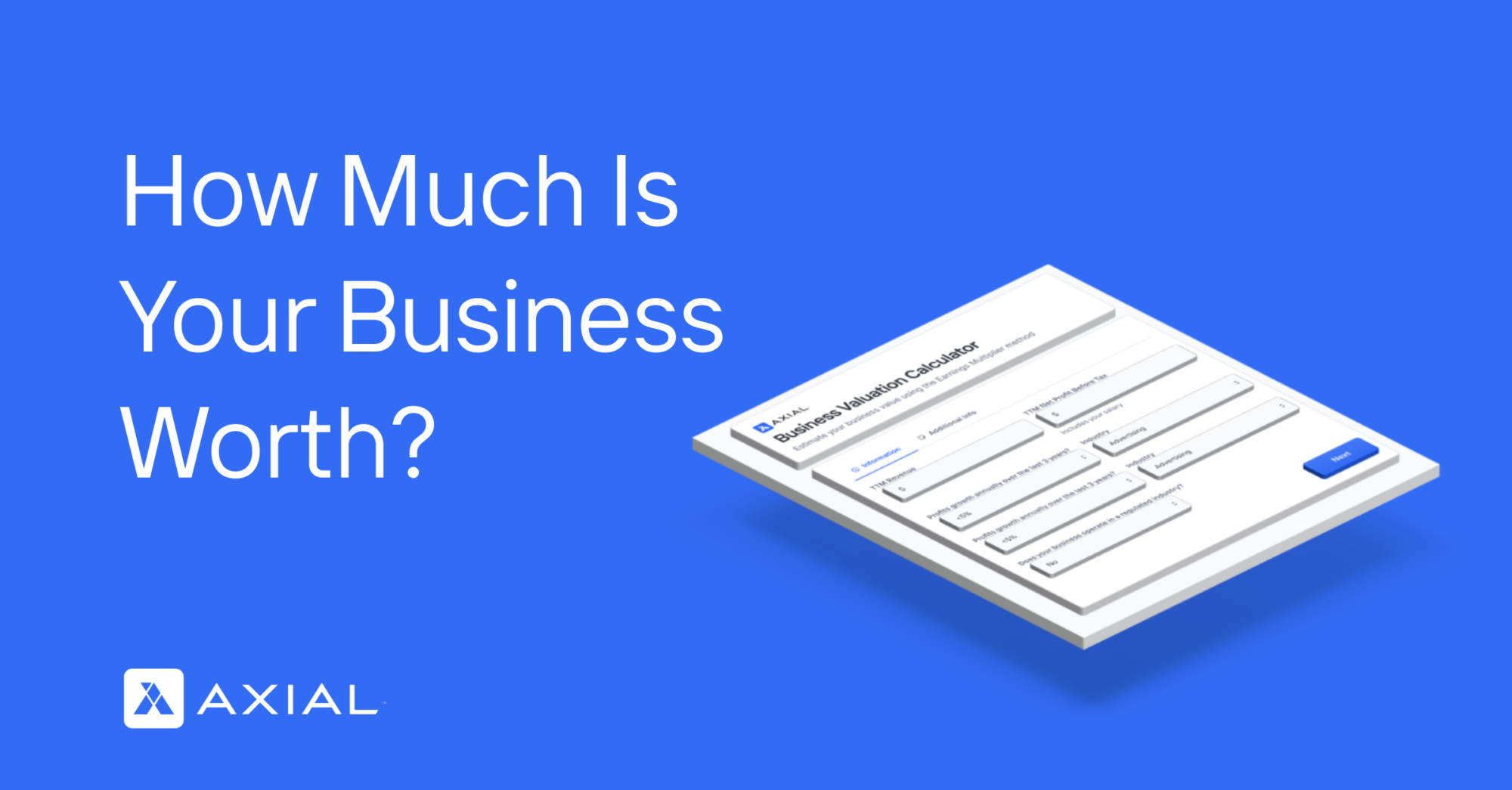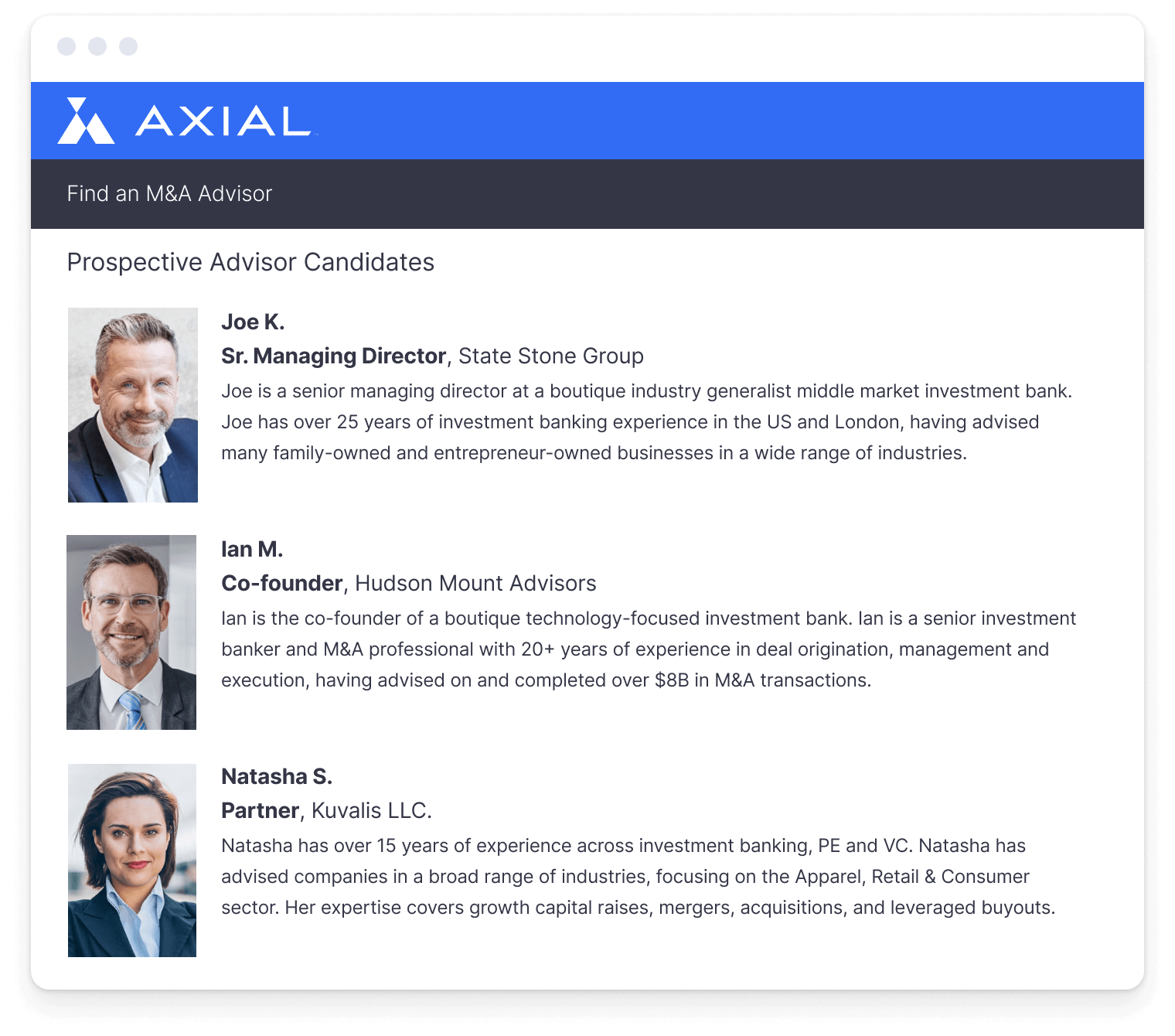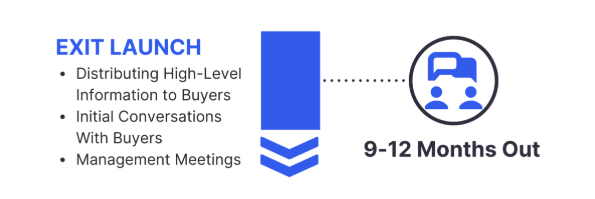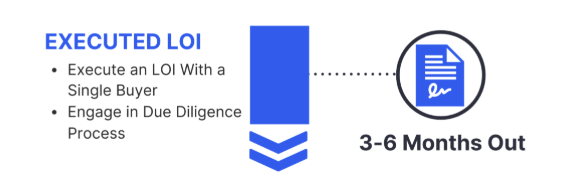
Introducing Axial’s Business Valuation Calculator – Find Out How Much Your Business Is Worth
The number one question our exit consultants hear from business owners is: “How much is my business worth?” To help…
We surveyed investment bankers to identify key factors that can derail a business sale.
One of the top factors is lack of formal exit planning, which can lead to:
This post covers the fundamentals of business exit planning, including objective setting, succession planning, and key decisions for a smoother, more successful exit.
We also explore how to execute your plan with a timeline to work towards your ideal exit date.
The insights shared here come from 14 years of experience with business owners and our network of 2000+ M&A advisors. Find out more about Axial’s M&A advisor network here.
Successful exit planning begins with clear goals and a commitment to leaving your business. It’s essential to define your objectives early on (we recommend 1000 days out from your ideal exit date), as they will guide all your decisions throughout the planning process.

Consider your personal goals and the future vision for your business. Like any goal setting in business, your exit goals should be specific, measurable, achievable, realistic, and time-bound, especially as you think about your ideal exit timeline.
There are countless questions to answer, but some of the most important are:
As you can see, exit objectives aren’t purely financial, which adds complexity to this stage of the planning process. For this reason, it’s important to set your goals in collaboration with your family and other key stakeholders.
By sharing your goals early, you can set expectations and create alignment, which is essential for a successful sale. The M&A process can be challenging, and involving those affected helps prepare them for the road ahead.
Once your goals are aligned, you can begin succession planning.
Your ultimate goal with succession planning is to make yourself redundant in the day-to-day operations of your company. This allows you to leave when you’re ready, without affecting the business’s value.
The best approach is to find the right people. At this stage, your goal is to identify internal candidates who can step into the roles you currently fill — or hire externally if no suitable candidate exists within your company.
This stage of exit planning involves:
Your succession plan may differ depending on the way you want to leave your company.
If you prioritize continuity and legacy, for example, you might put people in place who can ensure a smooth transition for your customers and employees. If you want to find a strategic buyer who will pay the highest price for your business, you’ll still need to appoint someone with in-depth knowledge of the company, but you may focus on candidates who can help assist with your company’s absorption.
You want to prepare your business records and financials to facilitate the sale. When your documents are clean, standardized, and organized, you can:
Your main focus will be organizing your financials. Collaborate with your accountant to ensure your record-keeping is complete and adheres to standard, detailed accounting practices, instead of a basic cash-in-cash-out model. Some sellers also opt for a Quality of Earnings report, which offers insights into the sustainability of their revenues.
Alongside your financials, buyers will want to see other documents that could affect the value of your business, such as leases, permits, licenses, and intellectual property agreements. Make sure these documents are complete and up to date.
Document your standard operating procedures and assess your operations to identify strengths, weaknesses, and areas for improvement. This preparation helps you confidently address buyer questions later in the process.
Early, thorough consideration of your exit goals, succession plan, and business documentation will demonstrate your commitment to leaving, prove that the business can run without you, and show its value to the right buyers.
So far, we’ve discussed exit planning as preparing for your business for sale. Once you’ve completed the planning phase, you’ll move on to the following stages:
Once you’ve determined your exit goals, created a clear succession plan, and prepared your business for sale, you can take concrete steps toward finding a buyer and exiting your company. Ideally, formal exit preparation should begin 15–18 months before your target exit date.

The most important task at this stage is hiring an M&A advisor to support you.
An experienced advisor has deeper industry knowledge than the average business owner, and their decisions are based on current market conditions.
Specifically, an advisor will:
Axial can help you find the best M&A advisor when you’re ready to manage your business sale.
We begin by pairing you with an Exit Consultant who learns about your business and exit goals. Your consultant uses our network of over 2,000 qualified, experienced, and vetted advisors to find those with a proven track record and high professionalism.
You’ll receive a shortlist of 3–5 advisors, along with insights to help you make your choice. Your Exit Consultant will also assist in preparing for the interviews, ensuring your personal information remains confidential until you’re ready to proceed.

The right advisor makes all the difference. With Axial, you gain access to unparalleled insights and expert guidance to help you find the best fit.
Once you’ve hired an advisor, they’ll start assessing your financials and stress-testing the goals and assumptions you outlined during your exit planning. This step acts as a safety net, ensuring you’re in a strong position to move forward with the sale.
They’ll always help you with the next essential step in your exit preparation: getting a formal valuation of your company.
An M&A advisor will help you determine an accurate valuation range for your business by integrating insights from three distinct analyses:
A key part of these analyses is sourcing the right data and making accurate assumptions about growth rates, buyer demand, and more. An M&A advisor with experience in selling business like yours will have proprietary data to more accurately value your business and support their assumptions.
With a better understanding of your business’s value, you can choose the right selling process. Again, this ties back to the question of stewardship versus price, which will help you create an ideal buyer profile.
For example, if maximizing the sale price is your goal, you might advertise your business more widely to foster a competitive bidding environment. On the other hand, if your business operates in a niche and you seek a buyer who genuinely values what you’ve built, you might prefer to curate a list of potential buyers.
As you prepare to engage buyers, setting yourself up for success begins with preparing your business marketing materials in advance.
This is another task for your advisor. While business owners can create these documents, advisors have the expertise and time to tailor them specifically to the buyer profiles you want to attract.
They’ll put together:
Advisors will use these documents to generate interest, protect your privacy, and further highlight the value of your business to buyers.
Once you’re ready to take your business to market, the next step is launching your business exit strategy and engaging with potential buyers. We recommend that business owners start distributing information to buyers and having these initial conversations 9–12 months before their planned exit date.

Again, your advisor is invaluable throughout these processes. Their role at this stage is strategic, using their experience to attract buyers who can help you meet your exit goals.
Your exit launch is shaped by the way you choose to share the marketing materials you prepared in the previous stage of exit planning.
Your advisor may adopt a targeted approach by presenting your teaser to a carefully curated group of potential buyers within their network. This strategy is ideal for businesses with strong buyer demand or for owners seeking a quick exit.
Alternatively, they may adopt a non-targeted approach, sharing your top-level marketing materials more widely. Without an advisor, casting such a wide net makes it hard to preserve confidentiality and differentiate serious buyers from tire kickers. However, your advisor can efficiently vet inquiries while safeguarding sensitive data about your company.
When you start receiving responses to your teaser, here’s the step-by-step process to follow:
As you approach the final stages of your exit, the goal is to execute an LOI (Letter of Intent) with one qualified buyer.

The LOI usually follows the IOI (though some buyers skip the interim stage) and demonstrates the buyer’s full commitment to moving forward with the sale.
As a business owner, you can only accept one LOI at a time, even if you received multiple IOIs after launching your exit. Accepting an LOI means entering into an exclusivity period (typically lasting 90–120 days) to ensure good-faith negotiations.
During this stage, both parties engage in comprehensive due diligence, which includes site visits where the buyer can assess the infrastructure firsthand and meet the succession team you’ve prepared. Your advisor is instrumental here, coordinating the process, addressing buyer questions, and keeping due diligence focused on key priorities.
The final step involves reviewing and negotiating the binding purchase agreement prepared by the buyer. This agreement outlines the final terms and structure of the sale. Your advisor plays a critical role in ensuring the terms align with your goals, identifying potential risks, and advocating for your best interests during negotiations.
Exit planning can begin years before your exit date, with early stages focused on gathering resources to understand the process, prepare your company, and build your team.
Whether you’re exploring options or preparing to engage with buyers, Axial’s Business Owner Resource Centre provides the resources and expert guidance to keep you informed throughout your exit planning.
Read more:
